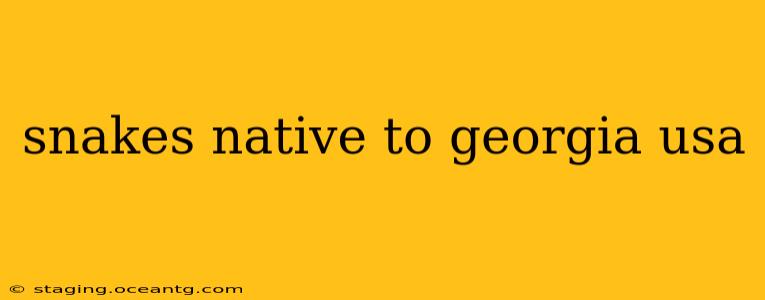Georgia boasts a diverse array of snake species, ranging from harmless garter snakes to venomous copperheads. Understanding these snakes is crucial for ensuring both human and snake safety. This guide provides a comprehensive overview of snakes native to Georgia, addressing common questions and concerns.
What types of snakes live in Georgia?
Georgia's varied landscapes, from the Appalachian Mountains to the coastal plains, support a wide variety of snake habitats. This results in a rich diversity of snake species. We can broadly categorize them into venomous and non-venomous groups. Venomous snakes in Georgia include copperheads, cottonmouths (water moccasins), timber rattlesnakes, and pygmy rattlesnakes. Non-venomous snakes are far more numerous and include species like black racers, corn snakes, garter snakes, rat snakes (including black rat snakes and eastern rat snakes), and many others. It’s important to remember that even non-venomous snakes can bite if threatened, but their bites are not medically significant.
What is the most common snake in Georgia?
Pinpointing the single most common snake in Georgia is difficult due to variations in habitat and reporting. However, several non-venomous species are widespread and frequently encountered. Black rat snakes and corn snakes are strong contenders for this title, due to their adaptability and widespread distribution across the state. Their prevalence in both rural and suburban areas contributes to their high visibility.
Are there venomous snakes in Georgia?
Yes, Georgia is home to several venomous snake species. The most frequently encountered are:
- Copperheads: Known for their distinctive copper-colored heads and hourglass-shaped markings. They are relatively common and found in a variety of habitats.
- Cottonmouths (Water Moccasins): These snakes inhabit swamps, marshes, and other aquatic environments. They are easily identified by their dark, often black, coloration and the white lining inside their mouths (which they display when threatened).
- Timber Rattlesnakes: Larger and more reclusive than copperheads, timber rattlesnakes are found in more forested areas. Their distinctive rattle is a clear warning sign.
- Pygmy Rattlesnakes: These smaller rattlesnakes are often mistaken for other snakes due to their subdued coloration and smaller size. They are still venomous, and their bite should be treated with the same seriousness as other venomous snake bites.
How can I identify a venomous snake in Georgia?
Identifying venomous snakes requires careful observation and attention to detail. While there are some general characteristics (such as a triangular head shape for some venomous species), relying solely on these can be unreliable. The best way to identify a venomous snake is through a combination of factors, including:
- Head shape: While not always definitive, venomous snakes often have a triangular or broader head.
- Body markings: Note the pattern and colors on the snake's body. Hourglass markings are a common characteristic of copperheads.
- Pupil shape: Venomous snakes usually have elliptical pupils, while non-venomous snakes typically have round pupils.
- Presence of a rattle: This is a clear indicator of a rattlesnake, though young rattlesnakes may have a very small or underdeveloped rattle.
If you are unsure about the identity of a snake, it is best to err on the side of caution and treat it as potentially venomous. Avoid handling unknown snakes.
What should I do if I see a snake in Georgia?
If you encounter a snake in Georgia, the best course of action is to:
- Observe it from a safe distance: Do not attempt to approach or handle the snake.
- Identify the snake (if possible): Take a photo if you can do so safely. This will help you determine whether it's venomous.
- Leave it alone: Snakes generally avoid humans and will move away if given the chance.
- Keep children and pets away: Prevent them from getting too close to the snake.
- Contact a professional if necessary: If the snake poses an immediate threat or if someone has been bitten, contact animal control or emergency services.
Understanding the snakes native to Georgia is crucial for coexisting peacefully and safely. By learning to identify them and understanding their behavior, we can reduce the risk of conflicts and protect both ourselves and these important creatures. Remember, the best way to avoid snake bites is to avoid contact with snakes altogether.
